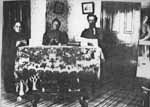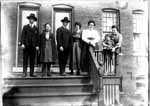The Famous Pullman Band
You are at Home -> The People of Pullman -> The Famous Pullman BandThe Pullman Band
George M. Pullman's vision for the town of Pullman and the Pullman Palace Car Factory included its ability to shape and reform his workers into an ideal - a worker without labor issues, enjoying a better standard of living, and given opportunities for self-betterment that would, of course, translate into more production for his factory. With these ideals in mind, and with the prodding, perhaps, of landscape architect Nathan F. Barrett (a member of the New York Athletic Club), Pullman began to incorporate the idea of social activities for his workers into his scheme. To promote this ideal, athletic clubs were formed. Athletic Island, a 10 acre playground was created in Lake Calumet with a grandstand, boathouses, a course for foot races and Pullman's various sports teams became renowned.
Parallel with the fervor for sports and the healthful benefits derived from such activities, was a similar movement in popular band development. When in 1882, a Canadian named Jacob F. Hostrawser arrived in Pullman and gained employment as a timekeeper, it was a fortuitous moment. He impressed Mr. Pullman with not only his skills at the factory but with his musical and organizational ability. It is said that not long after Mr. Hostrawser's arrival, Mr. Pullman supported his efforts to create the Pullman Band. A Pullman town newspaper clipping quoted in the Calumet Index of April 29, 1953 says "The Pullman band met for practice on the third floor of the water tower. The band was under the leadership of H.E. Crooks and later under Jacob Hostrawser." Perhaps the earliest incarnation of the band had Mr. Crooks as its manager while Mr. Hostrawser acted as Director. Certainly it was as Director of the Pullman Band that Mr. Hostrawser earned his famed reputation.
On 11 July, 1882, the group was formally organized as the Pullman Band. The band grew and matured rapidly in its first few years. By 1885 the band, photographed on the north porch of the Hotel Florence, had at least 29 members, including a drum major. The first uniforms were simple, with heavy braided frog closures on the jackets and hats with patches in front identifying the band as "PMB" - Pullman Military Band. A moustache seems to be a requirement of membership. The early drum displayed says simply "Pullman Band" and notes its date of organization. The first band featured cornets, trumpets, trombones, a tuba, euphoniums, a snare drum, bass drum, clarinets, flutes, and a piccolo.
Engagements for the band soon rolled in and in June of 1886, the Band began a series of free concerts in Arcade Park that would become a popular summer event for many years. By 1889 the Pullman Military Band had incorporated and secured a charter from the State of Illinois. On July 3rd of that same year, the Band gave a stirring patriotic program in Arcade Park complete with a cannon that, when touched off, blew the drummer clear off the bandstand. A rousing good time was apparently had by all. Hard work continued to pay off when the Pullman Band took first prize in the State band contest in Peoria in 1890. Sometime in 1891 the band procured new "Black Hussar" costumes for the then substantial sum of $3,200. These featured elaborate braided jackets, embroidered boots and curly lamb hats. Proudly displaying their new look, the band played the Sioux City Corn Palace this year as well as entertained a delegation of distinguished men representing iron and steel industries of Europe at a banquet in the Arcade Building.
In 1894 the Band became formally identified with the Illinois First Regiment, I.N.G. From this time forward, they traveled with the Regiment as well as represented Pullman in local, state, and country-wide performances. The Band inspired the formation of smaller groups of musicians within the Pullman Company and they provided patriotic programs throughout the First World War. Musicians from the Band entertained at company picnics and the Band entertained at numerous flag-raising events at different factory buildings on the Pullman site. Performances at the Arcade Building were a staple of their calendar and many residents enjoyed attending band practices, held on Wednesday evenings and Sunday mornings. The company supported the Band in all ways and Mr. Pullman was quoted as saying "You find the musicians and we will find them work". When the men of the band were away performing, they were docked their wages but they could keep whatever they earned playing. In 1892 it was reported in the Chicago Sunday Herald that the band was entirely out of debt and owned $10,000 in cash and property. At this time they were earning about $12,000 a year clear of expenses. J. F. Hostrawser continued as Director of the Pullman Band until his retirement from band work about 1917 or 1918. At this time he was the Chief Timekeeper for the Company. He died in June of 1922 but the band continued under William Schnell's direction until at least 1928.
THE PULLMAN HISTORY SITE

More Information About the People of Pullman
The People of Pullman
The Pullman House History Project

Arranged by:
Name
Address
Occupation
Birthplace
People of Color
Maps of Pullman
Images of Pullman People
Images of Pullman people
Other Pullman-Related Sites
- Historic Pullman Garden Club - An all-volunteer group that are the current stewards of many of the public green spaces in Pullman. (http://www.hpgc.org/
- Historic Pullman Foundation - The HPF is a non-profit organization whose mission is to "facilitate the preservation and restoration of original structures within the Town of Pullman and to promote public awareness of the significance of Pullman as one of the nation's first planned industrial communities, now a designated City of Chicago, State of Illinois and National landmark district." (http://www.pullmanil.org/)
- The National A. Philip Randolph Pullman Porter Museum is a 501(c)3 cultural institution. Its purpose is to honor, preserving present and interpreting the legacy of A. Philip Randolph, Pullman Porters, the Brotherhood of Sleeping Car Porters and the contributions made by African-Americans to America's labor movement. ((http://www.nationalpullmanportermuseum.com/)
- Pullman Civic Organization - The PCO is a strong and vibrant Community Organization that has been in existence since 1960. (http://www.pullmancivic.org/)
- Pullman National Monument - The official page of the Pullman National Park. (https://www.nps.gov/pull/)
- South Suburban Genealogical & Historical Society - SSG&HS holds the Pullman Collection, consisting of personnel records from Pullman Car Works circa 1900-1949. There are approximately 200,000 individuals represented in the collection. (https://ssghs.org/)
- The Industrial Heritage Archives of Chicago's Calumet Region is an online museum of images that commemorates and celebrates the historic industries and workers of the region, made possible by a Library Services and Technology Act grant administered by the Illinois State Library. (http://www.pullman-museum.org/ihaccr/)
- Illinois Digital Archives (IDA) is a repository for the digital collections libraries and cultural institutions in the State of Illinois and the hosting service for the online images on this site. (http://www.idaillinois.org/)


